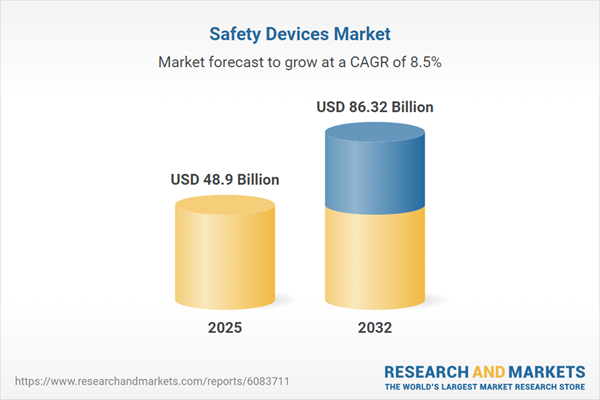Speak directly to the analyst to clarify any post sales queries you may have.
The global safety devices market is evolving rapidly, shaped by stricter regulations, advanced technology integration, and changing end-user demands across industries. Senior leaders recognize the landscape’s complexity—requiring robust strategies that account for both innovation and operational resilience.
Market Snapshot: Safety Devices Market Growth and Projections
The Safety Devices Market grew from USD 45.04 billion in 2024 to USD 48.90 billion in 2025. It is expected to continue growing at a CAGR of 8.47%, reaching USD 86.32 billion by 2032.
This growth trajectory reflects sustained demand for solutions that protect lives, assets, and operations across commercial, industrial, and residential environments, fueled by innovation and a continuously evolving regulatory context. Decision-makers in manufacturing, construction, energy, and related sectors are driving increased adoption of integrated safety mechanisms to anticipate both compliance and risk management needs.Scope & Segmentation of the Global Safety Devices Market
- Product Types: Emergency stop devices, fall protection systems, fire protection systems, gas detection devices, personal protective equipment, safety sensors.
- Emergency Stop Devices: Pull cord switches, push buttons.
- Fall Protection Systems: Guardrails, lanyards, safety harnesses.
- Fire Protection Systems: Fire alarm systems, fire extinguishers, sprinkler systems.
- Gas Detection Devices: Fixed gas detectors, portable gas detectors.
- Personal Protective Equipment: Gloves (latex, leather, nitrile), helmets (bump caps, industrial helmets), protective clothing, safety glasses.
- Safety Sensors: Motion sensors, presence sensors.
- Distribution Channels: Direct sales, distributors, online channels.
- End-User Sectors: Commercial, industrial (automotive, construction, food & beverage, healthcare, manufacturing, oil & gas), residential.
- Regional Coverage: Americas (North America—United States, Canada, Mexico; Latin America—Brazil, Argentina, Chile, Colombia, Peru), Europe, Middle East & Africa (Europe—United Kingdom, Germany, France, Russia, Italy, Spain, Netherlands, Sweden, Poland, Switzerland; Middle East—United Arab Emirates, Saudi Arabia, Qatar, Turkey, Israel; Africa—South Africa, Nigeria, Egypt, Kenya), Asia-Pacific (China, India, Japan, Australia, South Korea, Indonesia, Thailand, Malaysia, Singapore, Taiwan).
- Key Companies: 3M Company, Honeywell International Inc., Johnson Controls International plc, Siemens Aktiengesellschaft, Schneider Electric SE, DuPont de Nemours, Inc., Robert Bosch GmbH, MSA Safety Incorporated, Drägerwerk AG & Co. KGaA, Ansell Limited.
Key Takeaways for Senior Decision-Makers
- Heightened regulatory standards and risk management priorities are propelling the adoption of advanced safety devices across sectors.
- Digital transformation initiatives within industrial, healthcare, and energy environments drive demand for integrated safety platforms and real-time monitoring solutions.
- Manufacturers are investing in smarter sensors, modular products, and materials engineering to enhance performance, facilitate compliance, and optimize deployment efficiency.
- Distribution strategies must balance direct sales, distributor relationships, and online channels to maximize reach in diverse geographies and market segments.
- Emerging regional opportunities require customization to meet specific regulatory landscapes, infrastructure levels, and technology readiness.
Tariff Impact: Navigating New Cost and Supply Chain Realities
Newly implemented United States tariffs are impacting cost structures and component sourcing across the safety devices supply chain. This is prompting manufacturers to reassess supplier networks, pursue nearshoring, and explore alternative raw materials. The resulting shift in distribution and production priorities is fostering greater investment in localized manufacturing, automation, and resilient logistics frameworks to sustain operational continuity and margin performance.
Methodology & Data Sources
The analysis draws on primary interviews with industry leaders, product engineers, and channel partners, supplemented by secondary reviews of technical journals, regulatory documents, and industry reports. Extensive data triangulation ensures validation of both qualitative and quantitative insights, supporting a rigorous and objective market perspective.
Why This Report Matters for Leaders and Stakeholders
- Provides actionable insights to inform strategic planning and technology investment in the safety devices market.
- Equips leaders to proactively address evolving compliance, risk, and operational challenges.
- Offers detailed segmentation for targeted go-to-market strategies and regional expansion planning.
Conclusion
The safety devices sector demands agile adaptation, technology-driven solutions, and close alignment with both regulations and end-user needs. This report empowers senior executives to identify emerging opportunities, optimize operational strategies, and drive sustainable growth amid ongoing market transformation.
Table of Contents
3. Executive Summary
4. Market Overview
7. Cumulative Impact of Artificial Intelligence 2025
Companies Mentioned
The companies profiled in this Safety Devices market report include:- 3M Company
- Honeywell International Inc.
- Johnson Controls International plc
- Siemens Aktiengesellschaft
- Schneider Electric SE
- DuPont de Nemours, Inc.
- Robert Bosch GmbH
- MSA Safety Incorporated
- Drägerwerk AG & Co. KGaA
- Ansell Limited
Table Information
| Report Attribute | Details |
|---|---|
| No. of Pages | 198 |
| Published | November 2025 |
| Forecast Period | 2025 - 2032 |
| Estimated Market Value ( USD | $ 48.9 Billion |
| Forecasted Market Value ( USD | $ 86.32 Billion |
| Compound Annual Growth Rate | 8.4% |
| Regions Covered | Global |
| No. of Companies Mentioned | 11 |









